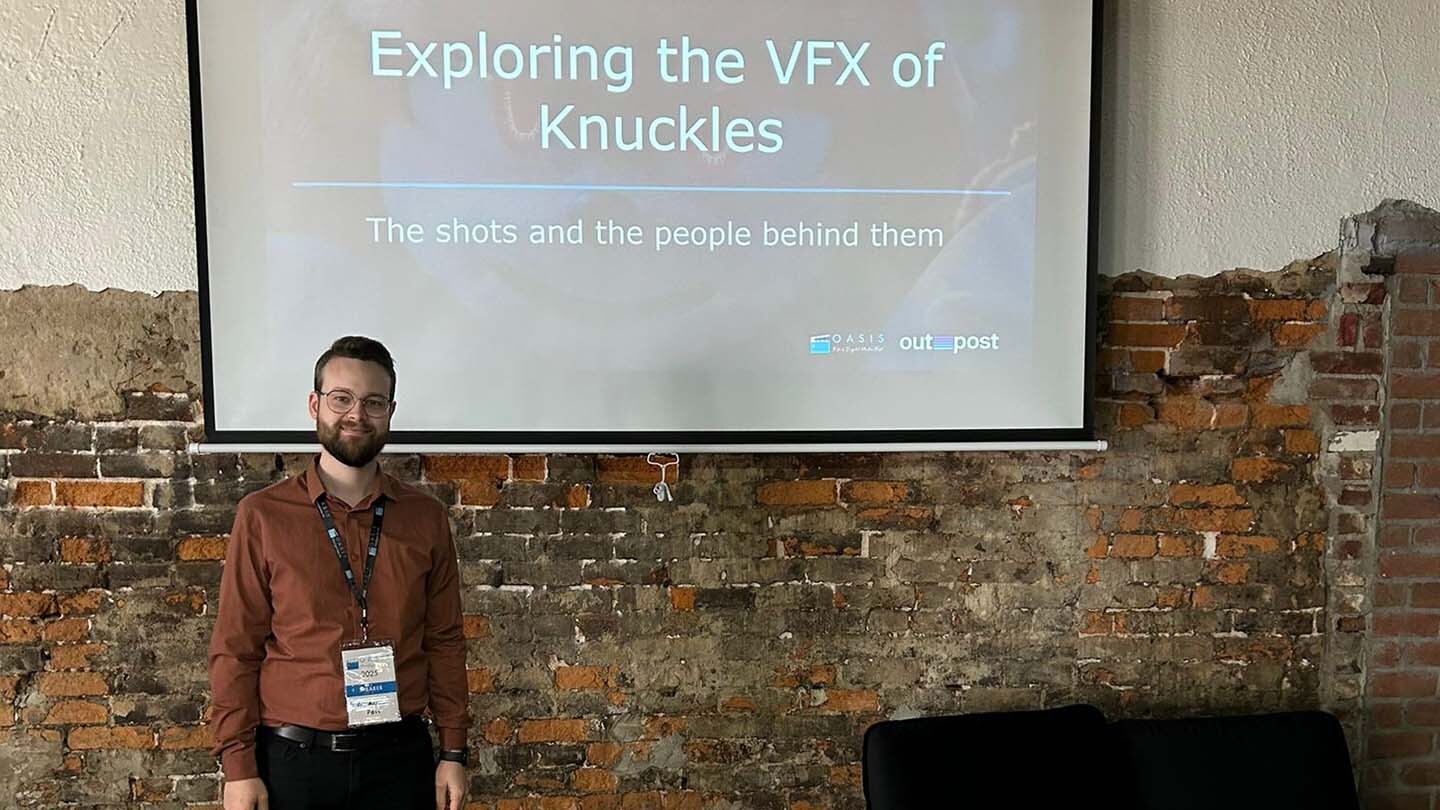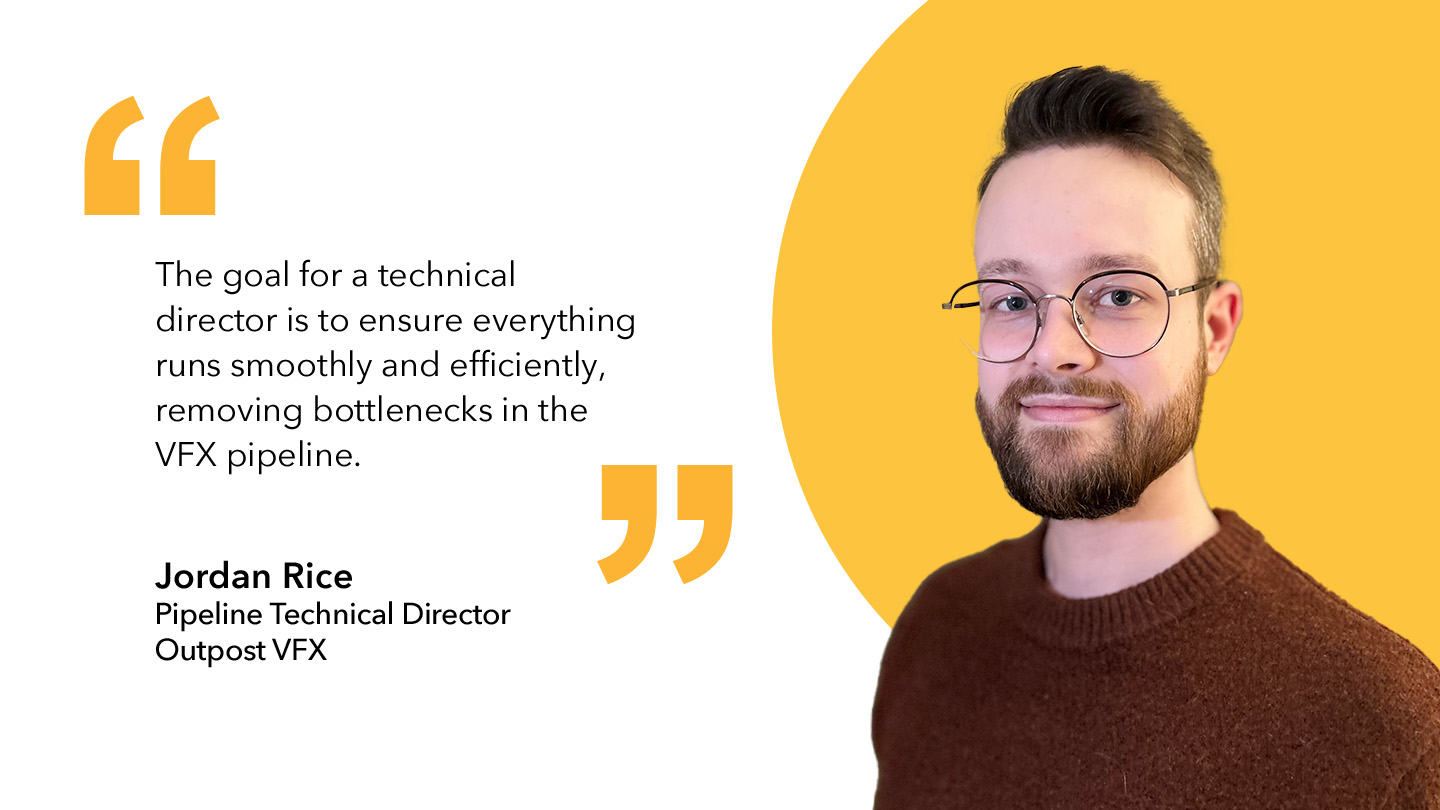テクニカルディレクターの役割とは?VFX業界の主要職種を徹底解説
VFXの世界は、非常に広く奥深い分野であり、高度な専門知識と多様なスキルが求められる分野である。アーティストだけでなく、サポートスタッフや技術担当、スーパーバイザーなど、さまざまなプロフェッショナルが力を合わせて、卓越した映像表現を支えている。では、VFX制作の現場には具体的にどのような職種があり、それぞれがどのような役割を担っているのだろうか。
最近開催されたイベントで、Paramount+の番組『ナックルズ』(『ソニック・ザ・ヘッジホッグ』映画シリーズのスピンオフ)のVFX制作について語ったOutpost VFXのパイプラインテクニカルディレクター、Jordan Rice氏は、本プロジェクトに関わったさまざまな職種を紹介した。
ランナーからテクニカルディレクターへ
Rice氏のキャリアは、スタジオ内のさまざまな雑務を担う「ランナー」として始まった。会議の準備やハードドライブの配達、社内イベントのサポート、新しいウェブサイトの移行作業など、制作を支える裏方としてさまざまな業務に携わった。やがて「ヘッドランナー」としてチームをまとめる立場となり、スタジオの運営の流れや、限られた時間の中で仕事を進める工夫、周囲の期待にどう応えるかといった実践的な力を身につけていった。さらに、業務の合間には独学でコンポジットの技術を磨き、着実にスキルアップを図っていった。

「“トレーニングルーム”というものがあって、そこには実際の制作システムの一部として使われていたコンピュータが並んでいました。過去の作品で使われたショットを使い、当時のブリーフ(指示書)に沿って練習できるようになっていたんです」と、Rice氏は説明する。「正式なトレーニングコースがあったわけではありませんが、フィードバックをくれるシニアスタッフが一人ついてくれていました」。
スキルを磨いたのち、Rice氏はテクノロジー部門に移り、データやサーバーの管理を担当するようになった。やがてソフトウェア、特にNukeに強い関心を持つようになり、その情熱がソフトウェア・テクニカルディレクターという新たな役職につながっていく。現在はOutpost VFXで、ツールの開発や新たなパイプラインの構築に携わりながら、制作現場を技術面から支えている。
優れたテクニカルディレクターに求められる資質とは
テクニカルディレクター(TD)は、アーティストが使用する制作環境やワークフローの構築・保守・最適化を担う役職である。技術的な問題の解決や作業の自動化を通じてアーティストをサポートし、すべてのツールで一貫した操作環境を提供する役割を果たしている。

「こうした対応は主にチケッティングシステムを通じて行われます」と、Rice氏は言う。「アーティストからは、作業ファイルの不具合やツールのバグ、あるいは欲しい機能が見つからないといった内容のチケットを送られてきます。私たちは、それぞれの要望に応じて必要なサポートを提供するのが役目です」。
テクニカルディレクターは、各部門の責任者と連携しながら、ワークフローを効率化する方法を検討したり、今後のプロジェクトに必要なツールを見極めたりする役割も担っている。さらに、人的ミスの防止を目的として、繰り返し発生する作業を自動化するなど、社内の業務プロセスの改善にも積極的に取り組んでいる。
「テクニカルディレクターの目標は、VFXパイプライン全体がスムーズかつ効率的に機能するようにすることです。ボトルネックを取り除くことが重要なんです」とRice氏は語る。
優れたテクニカルディレクターに求められる資質とは
優れたテクニカルディレクターは、プロジェクトの成功において欠かせない存在だ。では、優れたTDとは具体的にどのような人物なのだろうか。
「忍耐力、粘り強さ、そして学び続ける力ですね」とRice氏は言う。「業務の中には共通する部分もありますし、プログラミング言語の知識のように基礎となるスキルも重要です。ただ、ひとつひとつのタスクは内容が異なり、最初は何もわからないことも少なくありません。そんな中で大切なのは、辛抱強く取り組みながら、自分で解決方法を学んでいく力です。そして、チームで働くうえでは、助けが必要なときにそれを素直に求める判断力も欠かせません」。

VFXパイプラインとは何か
VFXパイプラインとは、ポストプロダクションにおける複数の工程を体系的にまとめたプロセスであり、各部門間のデータのやり取りを円滑に行うための重要な仕組みである。ワークフローの構築やツールの整備、作業の自動化など、あらゆる分野を包括している。
VFXの主要職種
以下は、OutpostにおけるVFXパイプラインの主な役割の一部です:
- マッチムーブ: 実写映像のカメラワークを正確にトラッキングし、それを3D環境に再現する工程を担当します。また、キャラクターの動きも解析して、フルCGのボディダブル(全身モデル)を作成し、エフェクトやライティングに活用します。
- モデリング: キャラクターや小道具、背景、衣装など、さまざまな要素をCGで立体的に造形する役割を担います。
- テクスチャ&ルックデベロップメント: Mariなどのツールを使って、モデルに質感や素材感を与える工程です。実際の色味やライティング、マテリアルに合わせてテクスチャを作成・適用し、現実感のあるビジュアルに仕上げていきます。
- リギング: アニメーターがキャラクターを自在に動かせるように、骨格や関節、筋肉の仕組みなどを組み込む工程です。リガーは、キャラクターを「操り人形」のように動かすためのコントロールを設定し、自然な動きを実現する土台を作ります。
- アニメーション: アニメーターはリグを使ってキャラクターに命を吹き込み、自然な動きや感情表現を生み出します。
- エフェクト(FX):FXアーティストは、雷や爆発、煙の軌跡、被毛などの視覚効果を作成します。
- ライティング: ライティングアーティストは、Katanaのようなツールを使ってCGに自然光や人工光を加え、シーンに自然になじむよう調整します。さらに、グロー(光のにじみ)などの効果を加えることで、映像に深みや臨場感を与えます。
- 背景制作: 背景アーティストは、CGを使って背景や風景を一から作成したり、既存の環境を拡張したりすることで、作品全体の世界観を構築します。
- デジタルマットペインティング: デジタルマットペインターは、複数の2D画像を合成して新たな背景を描き出すほか、リグやマーカーといった不要な要素を映像から違和感なく取り除く作業も担当します。
- ロトスコーピング(Roto): ロトアーティストは、映像内の対象物の輪郭をフレームごとにトレースし、マスクを作成することで、精密なコンポジット処理を可能にします。
- コンポジティング: コンポジターは、Nukeなどのツールを使って、実写映像(プレート)にCGやエフェクトを合成し、最終的な完成ショットを作り上げます。
VFXキャリアのはじめ方
VFX業界には実にさまざまな職種があり、自分に合った役割がきっと見つかるはずだ。VFX業界でキャリアを築くために大切なのは、「まず業界の人たちとつながること」だ、とRice氏は言う。たとえば、大学の卒業制作展は一般公開されていることが多く、学生や教授から直接アドバイスをもらえるだけでなく、スタジオの採用担当者も来場していることがあるため、業界への第一歩を踏み出す絶好のチャンスとなる。また、FMXやSIGGRAPHといったカンファレンスに参加するのも、業界内での人脈づくりに役立つ。
「私がパイプラインテクニカルディレクターという現在の職にたどり着いたのは、当時の業務で直面していた課題を解決しようと、Pythonでコードを書いてみたのがきっかけでした」とRice氏は語る。「自分にとって役に立ち、なおかつ興味を持てることに取り組んでみる、それがキャリアを築くうえでの良いスタートになると思います」。
学生向けのライセンスプログラムについては、Foundry Education ページで詳細をご確認ください。


